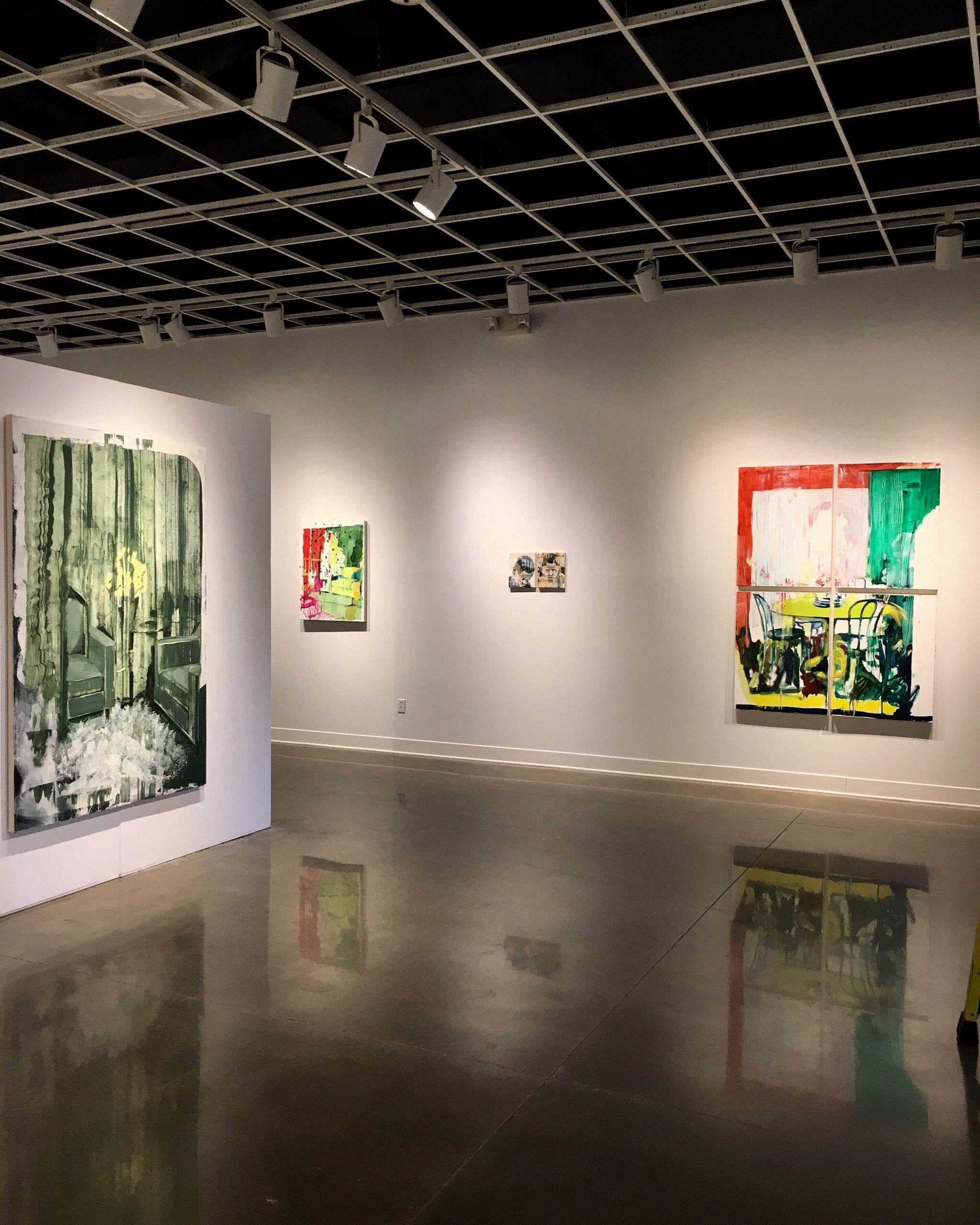Interior scenes have long captivated painters and viewers alike. These depictions of rooms, studios, and private spaces offer more than just decorative detail; they open windows into the intimate lives and inner worlds of their occupants. In contemporary art, interior-themed works bridge tangible environments and psychological states, inviting viewers to step into spaces laden with mood and meaning. Bartosz Beda’s Interiors Painting Series – available through his online gallery here – exemplifies this tradition’s evolution. This series not only dialogues with centuries of interior painting but also injects a unique conceptual approach that reflects on memory, perception, and the philosophical underpinnings of everyday spaces. Before examining how Beda extends this lineage, it is helpful to survey the historical evolution of interior painting and consider two renowned artists who made interior spaces a central theme, capturing private and psychological realms on canvas.
From Domestic Sanctuaries to Psychological Spaces: A Brief History of Interior Painting
Paintings of interiors first flourished as a genre in the Dutch Golden Age of the 17th century, when artists turned their attention to the quiet drama of domestic life. In this period, intimate household scenes became a subject worthy of high art. Johannes Vermeer, for instance, devoted his career to “tender moments of everyday life, documenting the private interior spaces of both mind and environment”.
His sunlit rooms with solitary figures engaged in reading or music-making are laden with a sense of stillness and introspection. These works were not just accurately rendered rooms; they were environments of contemplation. Vermeer’s interiors invite the observer to come closer and enter the scene, illuminating how physical surroundings can mirror an inner sense of peace or thoughtfulness. This early linkage of interior space and interior life set the stage for later artists to use rooms as metaphors for emotion and memory.
As art progressed through the 18th and 19th centuries, interior scenes remained a vital thread, evolving in response to changing artistic concerns. By the late 19th century, painters like the Danish artist Vilhelm Hammershøi pushed the interior genre into the realm of symbolism and psychological depth. Hammershøi became “best known for his paintings of domestic spaces, scantily furnished rooms with white walls… in which almost nothing is happening, but which suggest something profound and inexpressible about the nature of life and art”.
In his hushed depictions of sunlit parlors and closed doors, often with a lone figure turned away from the viewer, he imbued empty rooms with mystery and emotional weight. These works proved that an absent presence – an empty chair, a door ajar – could speak volumes about human loneliness, anticipation, or memory. Such interiors function as psychological portraits, encouraging viewers to project their own stories and feelings onto the tranquil scene.
Moving into the 20th century, artists increasingly leveraged interior settings to reflect the psyche amid modern life’s complexities. “Artists continued to paint indoor spaces throughout the 20th century for a variety of psychological, interpersonal, and biographical reasons,” an exhibition at UVA’s Fralin Museum noted.
The question arose: do these painted rooms mirror broader social realities, or do they instead illuminate the artist’s state of mind? Often, the answer was both. Many modernists and postmodernists turned inward – depicting studios, cafés, or living rooms – as theaters of existential drama or personal narrative. This trajectory culminates in contemporary practices, where interior scenes can be highly conceptual, layered with memory and meaning beyond their literal walls. Within this rich continuum, Bartosz Beda’s work enters a dialogue with the past while addressing present-day consciousness.
Vermeer’s Quiet Rooms: The Birth of the Private Interior in Art
One cannot discuss interiors in art without acknowledging Johannes Vermeer, a 17th-century Dutch master whose domestic interiors became synonymous with private tranquility. Vermeer’s small oeuvre (only about 34 paintings are firmly attributed to him) mostly consists of women and men absorbed in daily rituals – writing letters, playing music, or pouring milk – all within the confines of modest rooms. These scenes, rendered with exquisite care for light and texture, elevated the mundane to the poetic. Vermeer’s genius was in revealing the inner life through the portrayal of space. The serenity of indoor domestic spaces and the subtle interplay of light and shadow in his paintings suggest an atmosphere of contemplation.
In works like The Milkmaid or Woman Holding a Balance, the walls and windows are as much protagonists as the human figures, enclosing a world of thought and concentration. Art historians have noted that Vermeer’s interiors represent “the private interior spaces of both mind and environment”, epitomizing a cultural shift where the home was seen as a sanctuary of personal life. His paintings invite viewers into a hushed intimate world, encouraging a sense of empathy and reflection. In essence, Vermeer established the interior as a container of silence and thought – a theme that echoes through the ages of art.
Edward Hopper: Modern Interior as Psychological Landscape
If Vermeer’s rooms are serene sanctuaries, the 20th-century interiors of American painter Edward Hopper are arenas of solitude and psychological tension. Hopper’s iconic images of urban interiors – from lonely gas stations and hotel rooms to sunlit empty apartments – capture the alienation and introspection of modern life. His signature painting Nighthawks (1942) portrays figures in an all-night diner seen through a window, the harsh electric light illuminating their isolation amid a sleeping city. The scene, like so many Hopper compositions, is rich with what Alain de Botton called “a particular kind of alienated poetry”.
Hopper’s noirish, cinematic style is characterized by voyeuristic glimpses into private moments, a dramatic interplay of light and shadow, and figures who, even when together, seem emotionally worlds apart.
Crucially, Hopper’s interiors function as psychological landscapes. He stated that his aim was to paint himself, to project his inner state onto the canvas, rather than to caricature American life.
As a result, each room or interior space he painted – whether it’s a woman sitting alone in an Automat at night, or a couple not speaking in a sparse apartment – serves as a visual metaphor for loneliness, longing, or quiet introspection. Critics have observed that Hopper’s compositions render a kind of “psychological portrait” of both his subjects and himself.
In Sunlight in an Empty Room (1963), for example, the empty corner of a vacated room bathed in late afternoon sun evokes a poignant mix of loss and peace; no people are present, yet the space itself seems to resonate with memory. Hopper thus extended the interior genre to convey the emotional undercurrents of 20th-century existence – using the language of architecture and furniture arrangement as proxies for the unseen human narratives of hope, anxiety, and disconnection.
Bartosz Beda’s Interiors Painting Series: Extending a Tradition with Conceptual Depth
Entering this longstanding conversation of interiors is Bartosz Beda, a contemporary artist whose Interiors Painting Series pays homage to the genre’s history while infusing it with fresh conceptual vigor. At first glance, Beda’s interior paintings might appear straightforward: as the artist describes one piece, “what you see in the painting is pretty straightforward – a couple of chairs, a table, and an abstract background with a circle (or ball) in the middle.”
Yet, much like Vermeer or Hopper, Beda uses the ostensible simplicity of furniture and walls as a gateway to deeper meanings. He deliberately keeps the representational elements uncomplicated – chairs, tables, doors – to imply that the significance of the scene lies beyond the mere objects. “The simplicity of the subject matter implies the meaning of what is represented in the painting is something more psychological and philosophical,” Beda explains. In other words, the visible interior in his work serves as a canvas for the interior of the mind.
Beda’s unique approach often merges structure and abstraction, blurring the lines between a tangible room and an ethereal mental space. Many pieces in the Interiors Painting Series are divided into multiple panels or incorporate layered textures, disrupting the viewer’s sense of a single, coherent room. This fragmentation is intentional, echoing how memory and experience are seldom linear or whole. In paintings like Intentionally Exposed 02 (2019), which is split into four canvases, the familiar elements of an interior (chairs, a table) are re-contextualized amid swathes of abstract brushwork. The result is an interior scene that feels partly real, partly dream-like – as if we are seeing a living space through the prism of recollection or emotion.
Conceptually, Beda extends the interior-painting tradition by explicitly tying it to philosophical reflection. He compares the constancy of interiors in our lives to the rising sun – ubiquitous and taken for granted, yet fundamental to our daily existence.
Drawing on philosopher David Hume’s ideas about habit and expectation, Beda suggests that we invest interiors with a comforting sense of continuity: “We look at the interior, and we find in it the values and real existence that infer the existence of our own. It becomes the art of our interior.”
In this view, a painted room is not just a depiction of physical space but a mirror to the viewer’s own being and history. Beda believes that viewers instinctively project their emotions and memories onto interior scenes: “the interpretation of what we see in paintings of interior matters to us the most, as it refers directly to the emotions and memories from the past that also influence our present and the future.”
This insight aligns with the notion that an effective interior painting feels familiar – it resonates with one’s personal past, even if the specific room is unknown.
By engaging these ideas, Bartosz Beda’s Interiors Painting Series both honors and re-invents the genre. Like Vermeer, he finds profundity in ordinary rooms; like Hopper, he imbues spaces with psychological depth. But Beda introduces a contemporary twist: a conscious dialogue with the viewer’s own interiority and a blend of figuration with abstraction that transforms the “room” into a layered concept. His interiors are not fully inhabited by people, yet they are far from empty – they are inhabited by concepts, by the viewer’s gaze, by traces of stories. This series exemplifies how a modern artist can extend a rich tradition with personal style and thought-provoking nuance.
Collectors and the Allure of Interior-Themed Paintings
Interior-themed paintings have long held a special allure for collectors, not only for their aesthetic qualities but for the atmospheres and associations they carry. A painting of an interior can transform a real-world room in which it is displayed – it’s a window into another space and time, capable of profoundly affecting mood. Collectors of such works often speak of being “drawn into” a painting, as if stepping mentally into the depicted space. Indeed, interior paintings engage viewers on multiple levels, evoking:
- Atmosphere: The best interior scenes are laden with mood. Through judicious use of light, color, and composition, they conjure a specific ambiance – be it the quiet morning light of a Vermeer or the stark lamp-lit night of a Hopper. Collectors often cherish how an interior painting can suffuse their own living space with a particular emotional climate. The artwork becomes a kind of portal, making the viewer feel the warmth of a sunlit floor or the hush of a secluded study. This capacity to evoke atmosphere gives interior paintings a staying power; they continue to offer new emotional experiences upon each viewing.
- Memory: Interiors inevitably carry the poetry of memory. A simple image of a chair by a window can trigger personal reminiscences – of one’s childhood home, a cherished moment of solitude, or even an imagined nostalgia for a time never lived. As Bartosz Beda observes, interior paintings tap directly into the “emotions and memories from the past” of the viewer.
This quality often moves collectors. Acquiring an interior-themed artwork can feel like acquiring a piece of one’s own history or inner world, externalized on canvas. The painting’s scene might be foreign, yet something about the arrangement of objects and space resonates intimately, blurring the line between the collector’s personal memories and the artist’s vision. - Psychological Depth: Beyond mood and memory lies the introspective pull of interior paintings. These works can be profoundly metaphorical – a room can symbolize the mind, and objects can become stand-ins for feelings. Many collectors appreciate how a finely wrought interior scene invites slow, contemplative looking. There is always the sense of an unseen narrative: Who lives here? What occurred in this space? Is the room a refuge or a cage? Such questions spark the imagination. The psychological depth of interior paintings means they are not exhausted by a single glance; they encourage ongoing interpretation. In a collection, these works often become the ones that viewers return to repeatedly, finding new meaning in a tilted mirror or an open door left on the canvas.
Collectors engage with interior-themed art on these deeply personal levels, which explains why such works are often held dear in private collections. Owning a painting of an interior is akin to owning a beautifully bound novel or a piece of music – it creates an atmospheric and intellectual experience in the home. Moreover, interior scenes have a versatile appeal: they can complement modern minimalist decor as easily as they add a touch of nostalgic charm to classical settings, all while inviting meaningful interaction.
Beyond Monetary Value: Enduring Impact and Significance
While interior paintings can certainly be valuable in the art market, their significance to collectors and art lovers extends far beyond any price tag. In the realm of collecting, seasoned buyers understand that the worth of a work of art isn’t measured purely in dollars, but in the depth of connection it inspires. Industry experts note that collecting art is “not solely a financial endeavour; it is deeply intertwined with emotional and psychological factors”.
This is especially true for works that create an immersive world, like interior scenes. A collector might acquire a piece from Bartosz Beda’s Interiors Painting Series not as a speculative investment, but because it speaks to something profound in them – a reminder of their grandmother’s parlor, perhaps, or an echo of the solitude they treasure in their own life. Such emotional attachment can elevate the perceived value of a piece far beyond its market price.
The conceptual and artistic impact of interior-themed works gives them a timeless quality that persists even if market fashions change. Paintings that capture private spaces often reflect broader cultural or existential themes: the sanctity of home, the passage of time (seen in aging walls or fading light), or the tension between isolation and connection. These themes remain relevant across eras, which is why a Vermeer still moves us centuries later, and why Beda’s contemporary interiors resonate in today’s context. Collectors and critics alike recognize that such art contributes to an ongoing dialogue about the human condition. The value of owning a piece of that dialogue – being the steward of a painting that encapsulates atmosphere, memory, and psychology – is incalculable in purely monetary terms.
Furthermore, interior paintings often have a didactic or inspirative role in a collection. They encourage viewers to slow down and pay attention to the details of their own surroundings, much as the artist did. They serve as daily reminders of the beauty and meaning that dwell in ordinary sights – the fall of lamplight across a rug, the quiet order of furniture in a room. In this sense, the impact of such works is profoundly life-enriching. It’s not uncommon for collectors to describe living with a great interior painting as living with a wise companion – one that offers new insights or comfort over years. These are rewards that far transcend financial ROI. Indeed, the true investment made when acquiring an artwork like Beda’s Interiors is in one’s own cultural and intellectual enrichment. As one commentary on art collecting puts it, artworks carry “layers of meaning and value” – emotional, cultural, historical – that enrich the collector’s life beyond the canvas itself.
Conclusion
The tradition of interior painting, from its early flourish in Dutch genre scenes to its modern and contemporary incarnations, demonstrates the enduring fascination artists have with enclosed spaces and what they signify. These works turn the interior into a mirror, reflecting private moments and inner turmoils, quiet joys and unspoken tensions. Through the careful rendering of a sunbeam on a wall or the placement of a solitary chair, artists have captured not just rooms, but states of being. Bartosz Beda’s Interiors Painting Series stands firmly in this lineage, reviving and reinterpreting the interior genre for the 21st century. His paintings, with their blend of the concrete and the abstract, remind us that every room holds stories – some evident, many hidden. In engaging with such art, collectors and viewers participate in a rich exchange: the artist offers a space of contemplation, and we bring our own memories and emotions to it, completing the work in our minds. The result is a profoundly intellectual and emotional encounter with art. In a world increasingly dominated by the fleeting and the virtual, the painted interior remains a quiet, persistent sanctuary – one where value is measured not by currency but by the depth of experience it provides.








